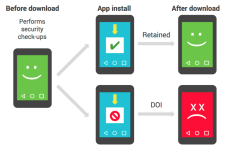<beginning of quote>
<end of quote>
Read Full Blog Post: Silence speaks louder than words when finding malware | Android Developers Blog
In Android Security, we're constantly working to better understand how to make Android devices operate more smoothly and securely.
<snip>
This blog post explores the Android Security team's research to identify the security-related reasons that devices stop working and prevent it from happening in the future.
Flagging Dead or Insecure (DOI) Apps
To understand this problem more deeply, the Android Security team correlates app install attempts and DOI devices to find apps that harm the device in order to protect our users.
With these factors in mind, we then focus on 'retention'. A device is considered retained if it continues to perform periodic Verify apps security check ups after an app download. If it doesn't, it's considered potentially dead or insecure (DOI). An app's retention rate is the percentage of all retained devices that downloaded the app in one day. Because retention is a strong indicator of device health, we work to maximize the ecosystem's retention rate.
Therefore, we use an app DOI scorer, which assumes that all apps should have a similar device retention rate. If an app's retention rate is a couple of standard deviations lower than average, the DOI scorer flags it. A common way to calculate the number of standard deviations from the average is called a Z-score. The equation for the Z-score is below.

Difference between a regular and DOI app download on the same device.

Results in the wild
Among others, the DOI score flagged many apps in three well known malware families— Hummingbad, Ghost Push, and Gooligan. Although they behave differently, the DOI scorer flagged over 25,000 apps in these three families of malware because they can degrade the Android experience to such an extent that a non-negligible amount of users factory reset or abandon their devices. This approach provides us with another perspective to discover PHAs and block them before they gain popularity. Without the DOI scorer, many of these apps would have escaped the extra scrutiny of a manual review.
The DOI scorer and all of Android's anti-malware work is one of multiple layers protecting users and developers on Android.
<snip>
This blog post explores the Android Security team's research to identify the security-related reasons that devices stop working and prevent it from happening in the future.
Flagging Dead or Insecure (DOI) Apps
To understand this problem more deeply, the Android Security team correlates app install attempts and DOI devices to find apps that harm the device in order to protect our users.
With these factors in mind, we then focus on 'retention'. A device is considered retained if it continues to perform periodic Verify apps security check ups after an app download. If it doesn't, it's considered potentially dead or insecure (DOI). An app's retention rate is the percentage of all retained devices that downloaded the app in one day. Because retention is a strong indicator of device health, we work to maximize the ecosystem's retention rate.
Therefore, we use an app DOI scorer, which assumes that all apps should have a similar device retention rate. If an app's retention rate is a couple of standard deviations lower than average, the DOI scorer flags it. A common way to calculate the number of standard deviations from the average is called a Z-score. The equation for the Z-score is below.
Difference between a regular and DOI app download on the same device.

Results in the wild
Among others, the DOI score flagged many apps in three well known malware families— Hummingbad, Ghost Push, and Gooligan. Although they behave differently, the DOI scorer flagged over 25,000 apps in these three families of malware because they can degrade the Android experience to such an extent that a non-negligible amount of users factory reset or abandon their devices. This approach provides us with another perspective to discover PHAs and block them before they gain popularity. Without the DOI scorer, many of these apps would have escaped the extra scrutiny of a manual review.
The DOI scorer and all of Android's anti-malware work is one of multiple layers protecting users and developers on Android.
<end of quote>
Read Full Blog Post: Silence speaks louder than words when finding malware | Android Developers Blog
- Android: Verify Apps - Protect against harmful apps - Accounts Help
- Android: Security System Updates - Android Security Bulletins | Android Open Source Project
- Android: Overview - Security